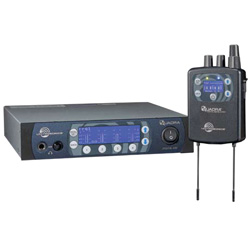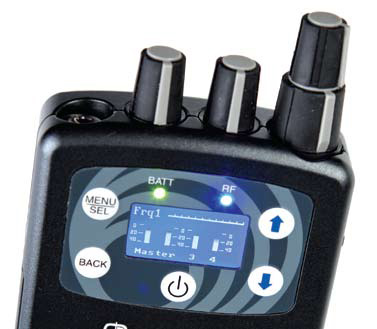
Goodbye FM
A little background about FM Multiplex stereo (MPX) as used in analog IEM systems is helpful. It uses pre- and de-emphasis to first boost high frequencies before transmission and then lower them in the receiver, to compensate for high-frequency noise in the transmission medium.
Stereo FM broadcasts are backwards compatible with mono receivers by design.
Left and right channels are encoded into a sum signal (L+R) and a smaller-magnitude difference signal (L-R), and mono receivers just use the sum. Stereo receivers add and subtract the difference signal to the sum to produce the original left and right signals.
The sum is transmitted as baseband audio from 30 to 15,000 Hz.
Frequency response above 15 kHz rolls off drastically because there’s a 19 kHz pilot tone (at 10 percent of full modulation) that tells the MPX circuitry to decode the 38 kHz difference signal. Because of the asymmetrical nature of MPX, stereo FM is more susceptible to noise and multi-path distortion than are mono transmissions.
Further, FM MPX stereo has channel separation of only about 65 dB.
That’s the equivalent of taking a stereo input and panning the channels to only “3 o’clock” and “9 o’clock” instead of hard panning them to “7 o’clock” and “5 o’clock.”
Let’s see, noise, lack of frequency response, lack of stereo separation. It sounds like in-ear monitor engineers and their customers have had to settle for an inferior transmission mechanism, just for the pleasure of going wireless. Not any more. Wait until you hear it.
Flexible Functionality
Quadra has two modes of operation, 4-channel and 2-channel. In 4-channel mode the upper dual-concentric knob controls master L & R, while the two single knobs control the third and fourth channels. The third and fourth channels can obviously be individual signals, or they can be groups of signals, such as all the guitars, or all the vocals.
Another mode of 4-channel operation is for the dual concentric knobs to each control the level of an audio channel (or subgroup) with the other two knobs controlling the third and fourth channels as before, providing 4-way control of all four channels.
Because this system really functions as a personal monitor system, it really depends on the user as to how they might want to operate it.
Some musicians will enjoy this level of control from their IEM, while others may find it confusing, annoying or distracting. For this and other reasons, Quadra also operates in a 2-channel mode, similar to previous IEM systems, but with superior sound quality than FM. In 4-channel mode, up to four systems can operate at once, while up to 8 systems can operate in 2-channel mode simultaneously.
Physical Facts
The beltpack is machined out of solid aluminum stock, similar to Lectrosonics SM Series super-miniature transmitters, and is finished with a special black powder coat chosen just for this product.
Because of the onboard DSP, it employs three AA batteries to provide up to 6 hours of use.
Outfitted with a sprint-steel beltclip and 1-inch by 1/2-inch backlit screen, the pack measures less than 3 inches by 4 inches by 1 inch – similar in size to other IEM packs. It employs antenna phase switching diversity reception and has two short ruggedized antennas. USB ports on both the transmitter and receiver are used for firmware updates.
The 4-channel transmitter comes in a familiar half-rack chassis that can be bolted together to put 2 channels in a single rack space. Its front panel has a larger display to monitor audio.
On the rear are four XLRs for analog signal input, the first two of which also serve as AES/EBU inputs. With analog inputs, the system has 1 millisecond (ms) of latency. With digital inputs, the latency is 0.5 ms.
There are just two caveats about this system. One is that ISM 915 MHz operation is limited to the South and North America, referred to as “Region 2” by the ITU, and in Australia and Israel, which allow it specifically. Lectrosonics is currently investigating solutions for Europe and Asia.
The other caveat is that once you start using a system with this much clarity, you’ll start to question everything else in your audio chain, because you’ve never heard IEM sound this good before, unless you’ve been using a hardwired system.
Finally, a wireless in-ear monitor system with studio-quality sound.
Mark Frink is editorial director of Live Sound International.

